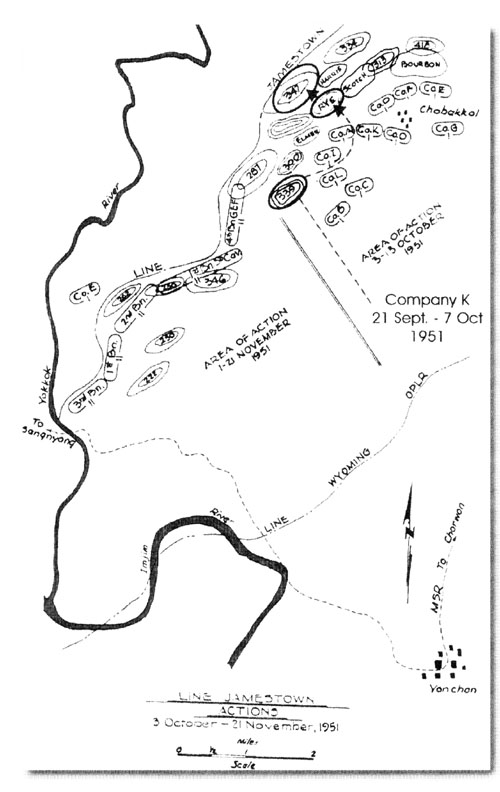My Maximum Attack Test
The Battle for Hill 347 - Bloody Baldy
As if the Defense of Hill 339 were not enough for Company K which ended September 29th, and cost us 54 casualties including one officer KIA, four days and NO replacements later, we were ordered to jump off in an attack toward a final objective - Hill 347, through objective Rye. This was Operation Commando, planned by Eighth Army. The strategic goal was to reach Line Jamestown across the front, which would force the Chinese Armies back across the Imjim River. And put great pressure on the North Korean Truce delegation, which was dragging its feet, back to the negotiating table at Panmunjom.
The following is a copy of part of what I wrote in the February, 1952 8 page letter to Captain Flynn
“Company K jumped off on 3 October with the 4th Battalion - the Greek Expeditionary Force, on the right of us, and Company L on our left.
More on the Greeks: While we were here fighting, one of their units close to us got surrounded by the Chinese. They radioed me to see if I could help out their beleaguered unit. I ordered lots of 81mm and 4.2inch mortar fire on the Chinese surrounding them, which let them fight their way out. The commander of the Greek Expeditionary Force, after the battles were over, awarded me and another company commander the Greek Cross of War.
Which was a high honor coming from descendants of the Spartans at Thermopylae. I wore that medal's ribbon next to my combat ribbons for several years.
Unfortunately when I went later to get the Army to enter that in my permanent records, the Greek Government said they had no record of it. Which they had to acknowledge before the US government would accept it. Even though I also had (and still have) the letter from the Commander awarding it. Seems like, after the commander returned to Greece there was a political upheaval. And that combat commander was on the wrong end of the political winner. So they conveniently 'forgot' anything he did. Except win battles in Korea. Which they did. They were great fighters.
Objective RYE
At the end of the first day's fighting on October 3d trying to take Objective Rye, the rest of my 1st Platoon was destroyed and two of my officers had been critically wounded. Company G had taken 130 casualties, including 4 officers, on Hill 418, and the Greek company on my right had taken 135 casualties. No units had gained their objectives. The 2d Battalion won and lost Hill 418 five times.
On the 4th of October we did the same thing with all the support we could muster, but again we were in the trenches and the Greeks were in theirs, but the tremendous mortar fire and unlimited number of enemy through us out with still more casualties.
I got 30 replacements that night, and never saw their faces in the light, before sending them into the attack. That was a terrible decision by higher headquarters to send me replacements, at night, while we were in the midst of combat. I had to send them down and distribute them to my platoons though I knew they would be forced to attack at dawn, before even getting to know their buddies they would be depending on. I could not hold them there, right in an open area near my exposed CP, which in daylight was in view of the enemy on higher ground. I had no shelter, and they did not have tools to spend the rest of the night digging foxholes. I swore I would never the rest of my career, send green replacements down to a unit while it is engaged in close combat.
On the 5th of October, the Greeks made it and we tried again. We couldn't make it until all the companies of our battalion attacked just after dark. We managed to capture the two little hills that were called 'Objective Rye' while suffering 17 more casualties, many in the trenches, including our artillery and 4.2-inch mortar forward observers.
On the 6th we reorganized while the Chinese threw 3,000 rounds into the Regimental zone. I only had two under strength rifle platoons and a mortar section left to fight with.
The REALLY Hard Fighting for 347
On the 7th of October we advanced on Hill 347, from Rye. all the elements of the battalion committed.
We, Company K, did a right hook into and up Hill 347. We reached the trenches and then were blown off the hill, losing another officer and 20 more men. Company L and I were on the other side of the peak, while Company L was fighting up the hill, Company I had to stop a counterattack against the battalion OP (observation point) behind them. The more senior officers and men in the OP were fighting off grenade attacks on their flank and were not much help to me or Company K.
The second time up we fell short of the trenches again, and were grenaded, machine gunned, and mortared off the hill, losing another officer and more men.
The third time we assaulted the same thing happened, and my last officer was wounded by a grenade and our attack was broken.
I had only six riflemen and Master Sergeant McKenzie left up on the hill, so I took all the rest of my small headquarters, the mortar crew as riflemen, and the remaining FO's. Loaded down with grenades, we all went forward. That was all who were left standing in Company K - 30 men. I would have to lead the last possible assault myself and stop trying to coordinating fire support against the defenders on top of the hill from my observation post
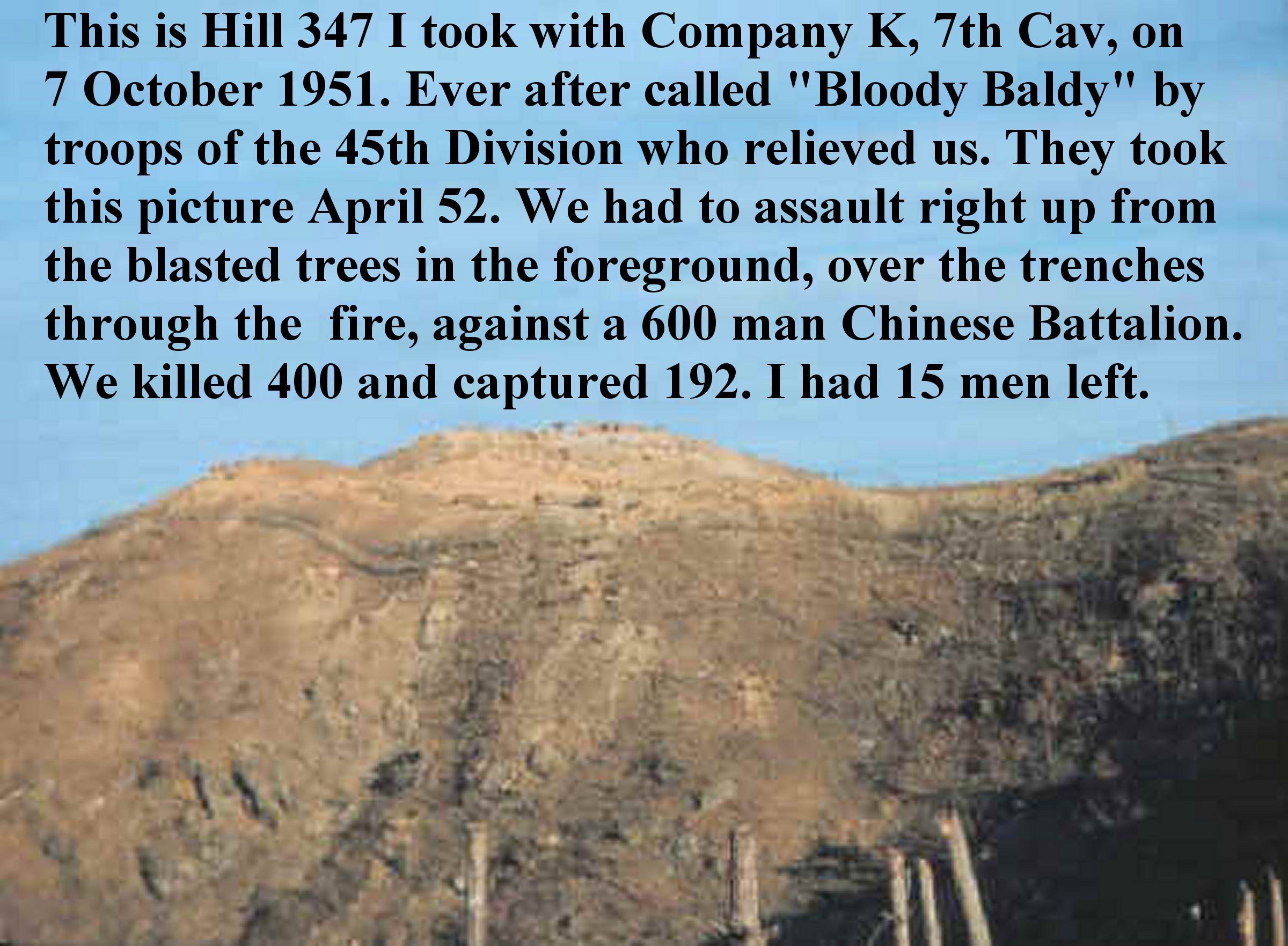
Some of the trenches that were on 347. Short tunnels branched off the trench line that circled the top of the hill.
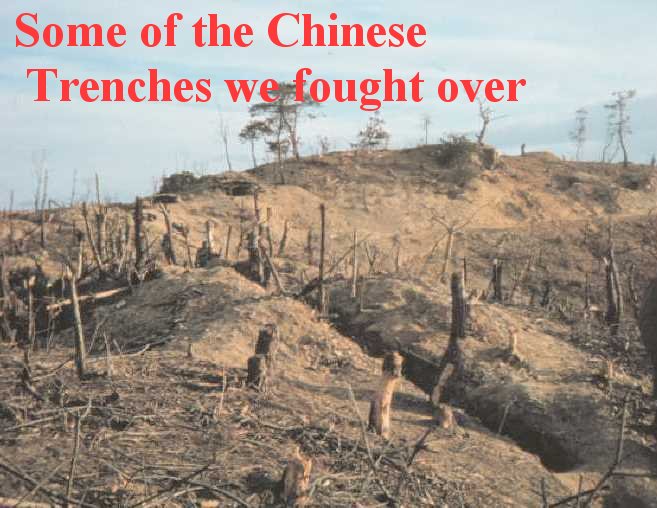
“There were about 30 of us in all, when we hit the hill. I could see one mistake earlier assaults had made. The men were not charging up over the trench at all costs and then turning and working down from above. The Chinese [many, many more than should have been there] were standing in four-foot trenches, where the direct fire from below, even tank fire, didn't bother them. They just threw an unlimited supply of grenades, including big anti-tank grenades, down the slope.
So when I took the last of Company K up - effectively just one platoon - I ordered everyone to run through the grenade fire and cross the trench, and try to keep their enemies down by massing our, largely carbine and submachine gun fire - (few riflemen were left.) I also radioed Sgt Chyzy's M Company Heavy Machine gun section which was down near the bottom, providing overhead fire for us and told him to keep firing, and not to hesitate if some of us got up on top and the Chinese came out of their holes and trenches to fight hand to hand. Fire at em even if we risk getting hit too.
It worked, sort of. Once I got on top alone after my Thompson sub machine gun ran out of ammunition, I suppressed the last resistance from bunkers with my grenades (and by throwing back some of theirs) my surviving 15 men followed. Chyzy stopped firing.
Two more FO crews had been killed by the rain of antitank grenades, and we lost about 10 more men who didn't make it. But we got across, and above that trench. The firing died down. Then lead men of Company L were able to come up the other side, once my remnants of Company K were in control on top.
I called the heavy machine gun section of Company M under Sgt Chyzy, to come forward to the top of the hill also after the firing died down. He still had 14 men left.
We threw all our remaining grenades in the battle on top, which forced the remaining Chinese back into their tunnels.
Then, one tunnel by one tunnel, we got them out as prisoners or dead men.
By dark we had 192 Chinese prisoners just from the area above the perimeter trench, which was only about 10 yards down, and 200 yards around the hilltop.
With all the attachments, including Chyzy's 14 man Company M machine gun attachment which joined us on top, I had 37 men, only about 15 left from Company K.
We discovered why they had held out so long. We had captured a Chinese division and regimental artillery headquarters, their supplies, and one, perhaps two battalion's guarding them. The senior Chinese commanders had bugged out the day before and a few hours before we got the hill. They left all the ammunition supplies for those two regiments. We counted 250 dead in the exposed trenches alone. Days later a clerk of the Chinese battalion defending the peak was captured. I still have his exhaustive report confirming that we had attacked a reinforced battalion he was in and captured or killed all but 80 men.”
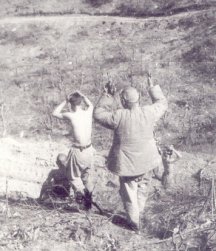
Three of the 192 Chinese Prisoners we took off Hill 347.
To my surprise their soldiers were so psychologically defeated by our relentless attack that they did not attempt to escape, either when all 192 squatted in a large circle on the flatter ground on top - and they saw we only had a handful of men left - or even when we had to march them, single file 2 miles down the mountains in dusk and then darkness to where the closest 2 1/2 ton trucks and Regimental Military Police could get to 347. While we had only 15 men spaced out along that column.
Some of my surviving men were so angry and emotional, some crying, on top, after seeing so many of their buddies killed and wounded in that huge fight for 347, they wanted me to let them kill - execute - our prisoners.
I understood their state of mind. But I said no, don't shoot unless they try to escape. Not just because the Geneva Convention said not to, but as American soldiers, it was not the thing we do - kill prisoners. While I was at the extreme limits of stress I could take, I still remained in control of myself and my sense of right and wrong. West Point had long ago helped instill that self-discipline and emotional control in me.
The only laugh of the day came when one Chinese soldier came out of his hole, cradling the tube of a 60mm mortar in his arms. He approached me and presented the mortar like a surrender sword from the Middle Ages - or as Confederate Commanders surrendered their swords to Union Commanders in the Civil War. Sergeant Kaser, who made it all the way from the Pusan Perimeter in July 1950 to being the last NCO standing - on Hill 347 with me on October 7th, 1951, reminded me of that laugh a few years ago, at a 7th Cav reunion.
But he also never forgave me for making him lead the long, long single file of prisoners over 2 miles down the mountain, after dark, with them at his back, and possible ambushes in front. while I was in the middle of the line and Sgt Chyzy's men were at the rear. In fact it was one of Chyzy's soldiers who took the only pictures of the prisoners, one of which I posted above. None of the Chinese soldiers tried to escape, even in the dark, so mentally dominated were they.
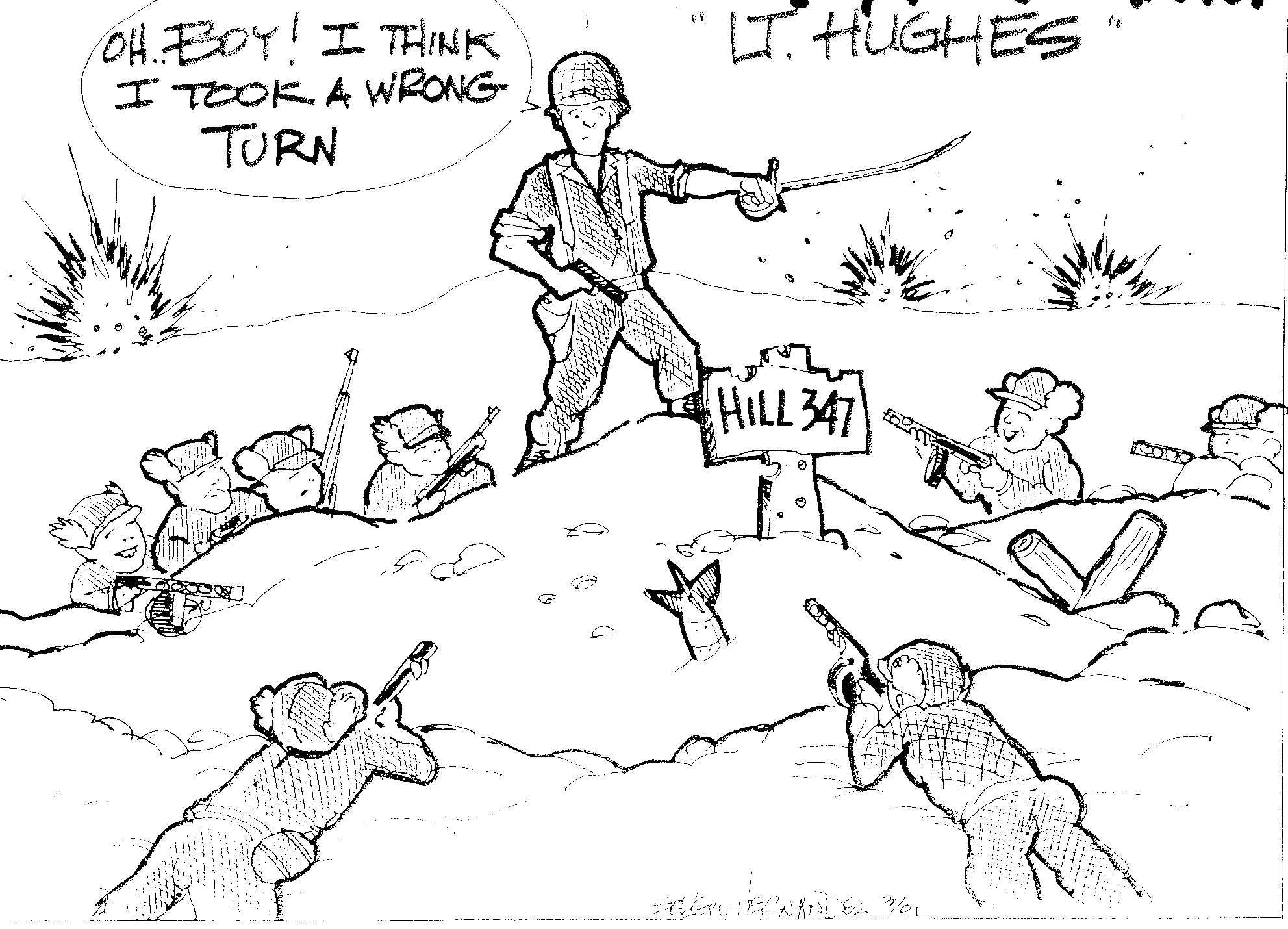
Aftermath
After we were relieved on the hill we went back to another part of the regimental front where the 1st Battalion had just been overrun; it was left with a captain as commander and had only 200 men.
Then we stayed rather stationary on the hills, except for a few more ordered patrols into enemy territory while the 5th and 8th Cavalry Regiments took ten more days to catch up and get their objectives. On one of those patrols, one of my soldiers, 'George' Pickett (a distant relative to THE George Pickett of Pickett's Charge' who lost at Gettysburg) got shot through the eye. He lived, but his eye did not. While we were fighting up Hill 347, the week before, PFC Pickett stepped in front of me to shield me and kicked a grenade aimed at me away down the slope before it exploded. Which is one reason I survived and got to the top before anyone else.
When we were on top after the battle, he took a leather belt off a dead Chinese soldier, and used it to hold up his pants. Even after he was wounded on that patrol, he kept hold of that belt, which had some Chinese markings on it.
Years later at a Company K reunion, Pickett, with a patch over his eye, came up to me and handed me that belt, asking me to keep it 'For Company K and the 7th Cav'
I still have it, and when my youngest son married the Chinese daughter of her Retired Chinese Army Colonel father (surgeon) I asked her to translate it. She did, and it only had the markings on the unit which existed when it was made.
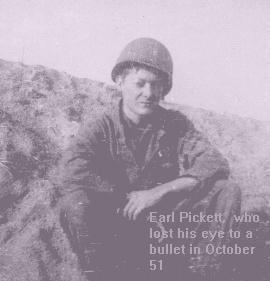
The last of the men who had been with us at the peak of the fighting were rotated then, and the last of the old Company K was gone. I was the only officer in the company for a while longer until they brought in a few. Then I was made assistant Regimental S-3 (operations officer).
And that's how we were when the division went into reserve, and got ready to ship out to Japan. The 1st Cavalry Division had taken a real pounding; it never suffered more casualties in an equal period during its tour in Korea. “
My Company K, lost 167 men and 6 officers over the 15 days of action, even though we won both big battles for Hills 339 and 347.
I was awarded the Distinguished Service Cross (DSC) for my actions, including arriving as the first American on top of 347 with only grenades, (having dropped my trusted Cal .45 Thompson machine gun on the slope after it ran out of ammunition) ending the battle.

The Map below summarizes the route and two major actions Company K was engaged over those last 15 days. The maximum successful defense, and maximum successful attack.
The After Truce Layout of Where We Had Been
The map section overlays those battle points in relationship to the southern half of the final Truce Demilitarized Zone (green lines) that still exists 60 years later.
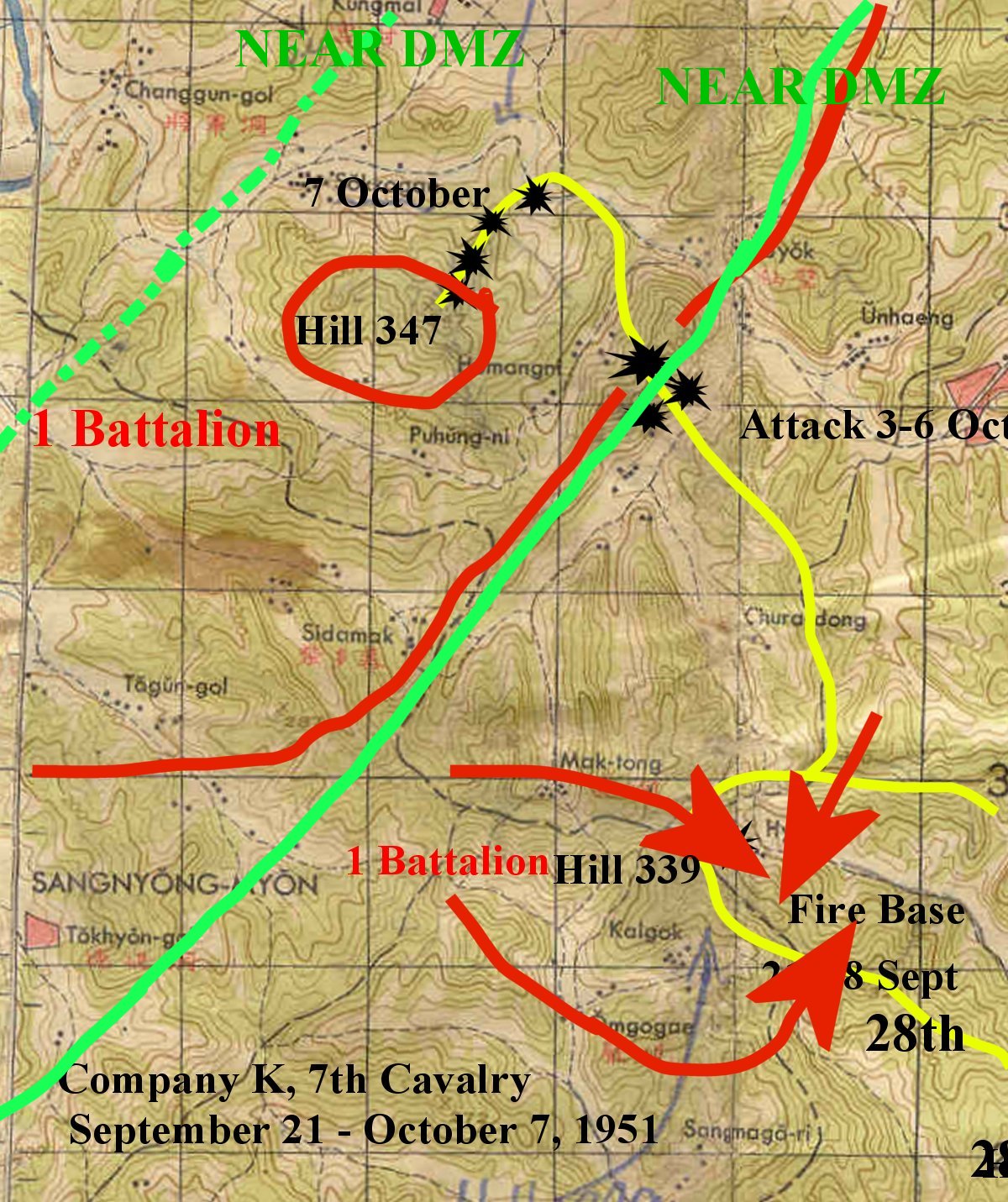
Another irony was that when I got to the top of Hill 347 and looked down to the north across the Imjin River which the Chinese unit remnants had to escape across, I saw a group of misshapen hills in the lowland below. They were later named "Pork Chop Hill' - which US troops fought over for the next year and a half, using Hill 347 as the staging base. Only then in 1953, was the Truce signed and shooting stopped.
I am proudest of the fact that Hill 347 is in the Demilitarized Zone, roughly on the 38th Parallel that still divides the North Korean dictatorship from the free, prosperous, South Korea republic.
Who said we did not 'win?' We went to war in 1950 to throw back the North Koreans and Chinese who had invaded South Korea, beyond the 38th Parallel -the original, internationally-recognized (UN) boundary between South and North Korea which was settled at the end of World War II. On October 7th, 1951 Company K, 7th US Cavalry, did so on Hill 347.
I never went back to visit Korea after the war. If I had I would wanted to stride on both Hill 339, now south of the DMZ, and 347 inside it.
But anyone who goes in there, gets shot.
Ironically that 2 1/2 Mile wide Demilitarized Military Zone, stretching from waters edge on the East to West Coast, with barbed wire fencing on both sides, wherein no-one is ever allowed to go, is one of the lushest environmental 'green zones' in the world today. Supporting small wildlife and birds.
Go figger.
I was awarded the Distinguished Service Cross for that Battle
See DSC under http://www.davehugheslegacy.net/index.php?option=com_content&view=article&id=225:me
Next Korean War (26)
